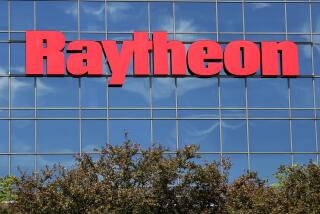Bomb-Maker Began Business in Market Stall in 1944
- Share via
Reading the annual report of Marquardt, the San Fernando Valley weapons maker, is a little like flipping through a Sears catalogue, with one very noticeable difference--the company isn’t selling monkey bars and tool kits.
On page after page are pictures of air-launched missiles, cluster bombs, turbines, warheads and plenty of other weapons and engines that Marquardt manufactures.
As a subcontractor to at least a dozen of the nation’s largest defense concerns, including some of those at the center of the Pentagon bribery and fraud investigation, Marquardt has worked on numerous weapons systems. Federal agents now say Marquardt itself is being examined in two federal investigations.
Was Aerospace Firm
The company was started in 1944 in a market stall in an outdoor West Los Angeles grocery by former USC instructor Roy Marquardt. It was then known as Marquardt Aircraft Co. and concentrated on aerospace work.
Today, weapons are a major focus. The Van Nuys company currently has more than $100 million in defense contracts and employs 1,100 workers.
In a $43-million deal, it was purchased in 1983 by International Signal & Control Group, a publicly owned $600-million Lancaster, Pa.-based electronics conglomerate.
Its current owner is Ferranti International, a Cheshire, England-based electronics company with $2.5 billion in sales and 26,000 employees, which merged with International Signal & Control Group in November, 1987.
“Ferranti is a household name in the world defense industry,” said Wolfgang Demisch, a defense analyst with UBS Securities in New York.
For a while, observers said, it looked as if Marquardt might become a defense and aerospace giant like Lockheed Corp. or Northrop Corp. But, in the late 1960s and early 1970s, when sales of one of its jet engines slumped, Marquardt gained new revenue by becoming a subcontractor to larger companies that designed weapons.
“Marquardt was one of the numerous offshoots in the flowering of the defense industry back in the 1940s, like TRW and Hughes,” said Demisch. “But they didn’t catch the same wave or grow to nearly the same size.”
Although a small company by industry standards, Marquardt makes products that have played an important role in U.S. military operations. For example, one of the bombs it manufactures--the Rockeye--was used extensively during the Vietnam War and during the April, 1986, American raid on Libya.
Marquardt designs and manufactures the metal parts and containers for bombs and so-called other dumb weapons--those with no artificial intelligence--for Honeywell Inc., Hughes Aircraft Co., LTV, Rocketdyne and numerous other companies. The firm sometimes builds and assembles everything but the actual explosive, which is usually inserted into the bombs on military bases.
Respected for its work, Marquardt has landed many important bomb and missile contracts. It has built the warhead for the AIM-9L Sidewinder air-to-air missile, the bulkhead of the Phoenix, a long-range air-to-air missile, and all of the metal parts for the TOW anti-tank missile, which often is fired from a hand-held device.
Makes Cluster Bombs
Still, about 60% of Marquardt’s annual $110 million in revenue derives from two cluster bomb projects: the Rockeye and the Tactical Munitions Dispenser or TMD. Marquardt has worked on the Rockeye for almost 20 years but has manufactured the TMD only since 1984.
The cluster bombs, usually weighing about 500 pounds, consist of a large metal case containing as many as 250 mini-bombs, which scatter like shrapnel when the case opens. “It opens like a clam shell, and all these small bombs fall out,” said Frank X. Marshall, Marquardt’s president since May, 1986. Human rights and disarmament activists have denounced use of the bombs as particularly inhumane.
Besides bombs and missiles, Marquardt manufactures thrusters currently used on 180 satellites and the space shuttle.
“These thrusters are not thrusters that take you from here to outer space,” Marshall explained. “These are thrusters that--once you get into space--you fire them and they reposition the capsule. They reorient it, turn it, aim it for reentry or taking pictures.”
With its thruster experience, Marquardt won a research and development contract for part of the jet engine for the National Aerospace Plane, a $30-billion commercial and defense vehicle which--if it works--is expected to haul passengers and military payloads into space and back like a regular airplane. The aerospace plane is a joint venture of the Defense Department and the National Aeronautics and Space Administration.
Marquardt has obtained much of its work by virtue of the fact that it is the designated “follower” for certain kinds of defense work. Under this system, the government requires prime contractors to find another company to serve as a backup or follower in case the prime contractor suddenly is unable to continue producing a weapon system.
By law, the prime contractor is required to teach the follower everything there is to know about the weapons system it is manufacturing. Usually, the follower ends up producing some of the systems itself.
Marquardt itself has hundreds of companies working for it as subcontractors. Many are small Southern California machine shops, which are awarded contracts from Marquardt to manufacture small components such as a section of a missile’s tail fin.
More to Read
Inside the business of entertainment
The Wide Shot brings you news, analysis and insights on everything from streaming wars to production — and what it all means for the future.
You may occasionally receive promotional content from the Los Angeles Times.









